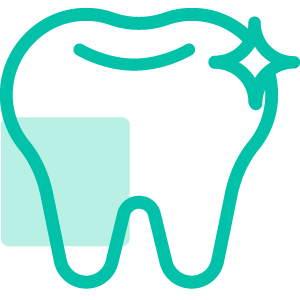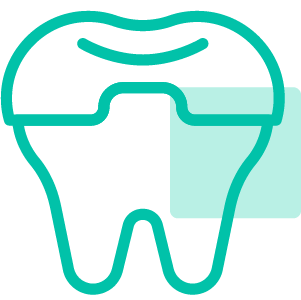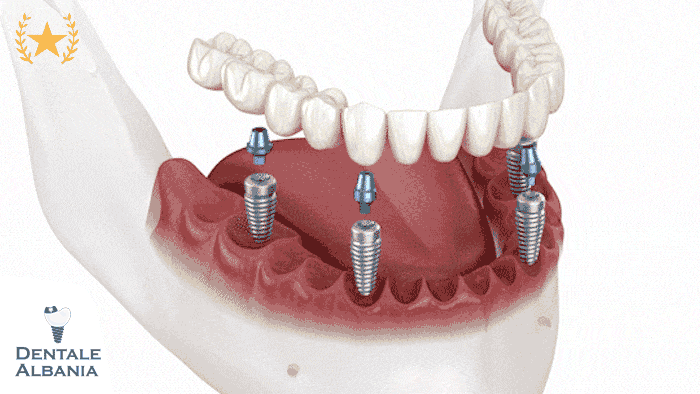Table of Contents
ToggleWhat Is Cavities-Tooth Decay?
Tooth decay — also referred to as dental decay, tooth caries, or cavities — is one of the most widespread oral health problems affecting people of all ages. But what exactly is it? At its core, a cavity is a hole in a tooth caused by decay in the tooth enamel, which can deepen and spread to other layers of the tooth if left untreated.
Cavities occur when bacteria in the mouth feed on sugar and starches from food and produce acids. These acids wear down the tooth enamel, leading to tooth cavities and eventually more severe damage. When ignored, this process can result in a rotten tooth, pain, infection, or even tooth loss.
- A tooth cavity may start small and go unnoticed at first, especially in areas like the back molars where decay is harder to detect.
- If not treated, the cavity decay spreads into the dentin and eventually reaches the pulp, causing increased tooth decay pain and infection.
- Advanced cases result in teeth rotting or decayed teeth, often requiring extensive treatment such as root canals or extractions.
Common terms used to describe these problems include:
- Cavity in teeth
- Teeth with caries
- Cavity tooth
- Tooth rot
- Decaying teeth
- Rotting molars
Importantly, cavities and decay of tooth enamel are largely preventable with proper dental care and awareness. Understanding what is tooth decay, what is a cavity in a tooth, and the processes that cause teeth to rot can help individuals take proactive steps to maintain oral health.
In the following sections, we’ll explore symptoms, causes, stages of tooth cavity, treatments like tooth caries treatment, and how to prevent severe dental decay before it becomes irreversible.
What Are the Symptoms of a Cavities-Tooth Decay?
Recognizing the early signs of cavity tooth or tooth decay symptoms is crucial for preventing serious dental complications. While cavity decay tooth can progress quietly at first, certain symptoms of tooth decay start to appear as the condition worsens.
Let’s explore the most common warning signs:
What Does a Cavity Feel Like?
In its early stage tooth decay, a cavity may not feel like anything at all. However, as the decay progresses:
-
- You might experience tooth sensitivity when eating or drinking hot, cold, or sweet items.
- You may notice a toothache that’s either constant or comes and goes.
- A hole in tooth may become visible or noticeable when you run your tongue across the teeth.
What Does a Cavity Look Like?
Tooth cavities often appear as:
-
- White spots indicating early tooth decay (loss of minerals in enamel).
- Dark brown or black spots as the decay in tooth deepens.
- Holes in teeth or tooth holes that you can see or feel.
Can Tooth Decay Cause Bad Breath?
Yes, bad breath or an unpleasant taste in the mouth is often associated with:
-
- Rotting teeth or infected decayed back teeth.
- Accumulated bacteria in holes in molars or hidden cavities.
What Happens If You Have a Cavity for a Long Time?
If untreated, cavities in the teeth continue to erode the tooth structure and can lead to:
-
- Severe tooth cavity and pain.
- Infection of the pulp and formation of a dental abscess.
- Potential loss of the decayed tooth, affecting chewing and alignment.
In conclusion, being alert to signs of dental cavity, such as decay side of tooth, pain, or visible cavity on molar tooth, can help you act early. If you’re experiencing tooth cavity symptoms, especially pain in a molar, it’s time to see a dentist for cavity diagnosis and treatment.
What Are the 5 Stages of Tooth Decay?
Understanding the stages of tooth decay is essential to catching the problem early and preventing irreversible damage. Tooth decay doesn’t happen overnight. Instead, it progresses gradually through multiple phases — from subtle mineral loss to severe tooth cavities that may require extensive dental work. Here’s a breakdown of the 5 primary stages of decay in teeth with caries.
What Does a Stage 1 Cavity Look Like?
Stage 1: Demineralization
-
- The earliest sign of cavity tooth formation is the appearance of chalky white spots on the enamel.
- These white spots indicate mineral loss due to acid attacks from plaque and bacteria.
- At this point, the damage is not yet permanent and can still be reversed with fluoride and improved oral hygiene.
- This is often referred to as early stage tooth decay, and it’s the best window for intervention.At this stage, you likely won’t feel any discomfort, and the decay hasn’t created any holes in teeth yet. Regular dental checkups can help spot this silent phase of tooth rot.
What Happens When Tooth Decay Reaches the Pulp?
Stage 4–5: Pulp Involvement and Abscess Formation
-
- As decay progresses through the enamel and dentin layers, it eventually reaches the pulp, the soft inner core of the tooth that contains nerves and blood vessels.
- This is when pain becomes sharp and constant. You may experience throbbing, sensitivity, and swelling.
- Tooth cavity decay at this level can cause a dental abscess, which is a pocket of pus due to infection.
- Without prompt treatment, the infection can spread to nearby teeth and even enter the bloodstream.
Treatment options at this point usually involve a root canal to clean out the infected pulp or in severe cases, tooth extraction if the tooth is beyond saving.
From the first signs of cavity tooth to a full-blown rotten molar, the decay process is preventable with good care and attention. Recognizing these five stages gives you the advantage of stopping decay before it requires invasive treatment.
What Are the Signs and Symptoms of a Cavity?
Recognizing the symptoms of cavities and tooth decay early can prevent the need for extensive treatment. While some people might not feel anything until the cavity in teeth has reached the inner layers, there are signs that can alert you to the presence of tooth decay before it gets worse. Ignoring these signs can lead to rotting teeth, infections, and even tooth loss.
Here’s how to tell if you may have cavities in the teeth or decayed teeth.
- Tooth sensitivity – One of the earliest warning signs. You may feel pain or discomfort when consuming hot, cold, or sweet foods and drinks.
- Toothache – A persistent or spontaneous toothache can be a sign that the decay has reached the dentin or pulp.
- Visible holes or pits – Small visible holes in teeth (especially molar tooth decay) could indicate a developing tooth cavity.
- Discoloration – Brown, black, or white spots on the tooth surface are often signs of early tooth decay or more advanced cavity decay tooth.
- Bad breath or foul taste – Caused by bacteria thriving in areas of decay, these can be telltale signs of a decayed tooth or rotting tooth.
- Swelling or bleeding gums – In some cases, particularly if the decay is close to the gum line, inflammation may also occur.
At What Stage Does a Cavity Hurt?
- Pain usually starts when decay reaches the dentin layer of the tooth, which is softer and more sensitive than enamel.
- If the cavity tooth progresses further into the pulp, the pain becomes more intense and constant.
- At this point, chewing or even light pressure on the tooth can cause severe discomfort.
- This is often when people realize they need to see a dentist for cavity treatment.
What Does a Cavity Smell Like?
- A cavity or rotting molar can produce a distinct bad odor due to bacterial buildup.
- The smell is often described as foul or metallic, and it may come with an unpleasant taste in the mouth.
- Halitosis (chronic bad breath) is common in people with severe dental decay, especially if it’s untreated.
If you notice any of these symptoms, even if they’re mild, it’s essential to schedule a dental check-up. Early detection and treatment can prevent further decay of tooth enamel and protect your oral health.
What Causes Cavities and Tooth Decay?
Understanding the root causes of cavities and tooth decay is essential for both prevention and effective treatment. Tooth cavities, also known as dental caries, are not caused by a single factor but rather a combination of behaviors, bacteria, and conditions. These causes lead to the formation of cavity teeth, holes in teeth, and eventually decaying teeth if left untreated.
Here are the most common contributors to tooth rot and cavity decay:
- Sugary and starchy foods – Frequent consumption of items like candy, soda, cookies, and bread feeds acid-producing bacteria in the mouth.
- Poor oral hygiene – Infrequent or improper brushing and flossing allows plaque (a sticky bacterial film) to build up, leading to acid erosion and cavity formation.
- Dry mouth – A lack of saliva reduces the natural ability to wash away food and neutralize acids, making teeth more prone to decay.
- Frequent snacking or sipping – Constant exposure to sugar or acid-rich beverages, like soft drinks or fruit juices, increases the risk of enamel breakdown and cavity mouth issues.
- Receding gums – Exposes tooth roots, making them vulnerable to root decay and decay side of tooth problems.
- Worn dental work – Old fillings or poorly fitting dental appliances can trap plaque and allow decay in tooth areas to worsen.
- Acid reflux or eating disorders – Stomach acid can reach the mouth and damage enamel, accelerating the process of tooth decay.
What Are the Main Causes of Tooth Cavity Formation?
- Plaque buildup – The main culprit behind tooth decay is dental plaque. When not removed, plaque hardens into tartar, making it even harder to clean the teeth and remove bacteria.
- Bacterial acids – Specific bacteria in the mouth feed on sugars and starches, releasing acids that erode enamel, leading to cavity in teeth.
- Inadequate fluoride – Fluoride helps remineralize enamel and prevent cavities. Lack of fluoride, whether in water or toothpaste, weakens enamel.
- Not brushing after meals – Leaving food particles and sugars on your teeth gives bacteria time to cause early stage tooth decay.
Can Cavities Be Contagious?
- While tooth decay itself isn’t contagious, the bacteria that cause it can be transmitted through saliva.
- Common ways include sharing utensils, kissing, or cleaning a baby’s pacifier with your mouth.
- This is especially concerning for infants and young children, as they can develop baby bottle tooth decay from early bacterial transmission.
These insights reveal that cavities aren’t just about sugar—they’re about habits, hygiene, and overall health. Preventing decayed teeth starts with understanding and addressing these causes proactively.
Can Tooth Decay Be Reversed or Stopped?
A common question many people have is whether tooth decay can be reversed or stopped once it starts. The good news is — yes, but only in the early stages. Once cavities or holes in teeth form, the damage becomes permanent and requires professional treatment. However, in the early phases, known as demineralization, it’s possible to halt or even reverse decay with proper care.
Here’s how you can help your teeth recover before a full tooth cavity develops:
- Fluoride use – Fluoride is your first line of defense. It helps strengthen enamel by encouraging remineralization and making teeth more resistant to acid attacks. You can get it through toothpaste, mouth rinses, and in-office treatments.
- Dietary changes – Reducing sugar and acidic food intake allows your saliva to do its job in neutralizing acids and repairing enamel.
- Oral hygiene habits – Brushing twice a day with fluoride toothpaste and flossing daily removes plaque, the primary contributor to cavity formation.
- Regular dental visits – Early signs of early stage tooth decay are often invisible to the naked eye. Dentists can detect and treat decay before it progresses.
How to Reverse a Cavity Naturally
Natural methods can support enamel remineralization in the earliest stages of decay:
- Use fluoride toothpaste – Fluoride encourages the natural repair process of the enamel and is especially helpful in reversing white spot lesions, the first visual sign of decay.
- Chew xylitol gum – Xylitol helps stimulate saliva production and can inhibit cavity-causing bacteria.
- Eat enamel-friendly foods – Leafy greens, cheese, and other calcium-rich foods help restore lost minerals.
- Avoid sugary snacks – Limit between-meal snacking to give saliva time to neutralize acids.
- Drink fluoridated water – A steady source of fluoride is one of the most effective ways to protect your teeth daily.
What Kills Cavities in Teeth?
While you can’t technically “kill” a cavity, you can eliminate the bacteria causing it and stop it from worsening:
- Professional dental cleanings – Remove hardened plaque (tartar) that traps bacteria and acid.
- Antibacterial rinses – Products like chlorhexidine or fluoride mouth rinses reduce harmful bacteria in the mouth.
- Fluoride varnishes – Applied by dentists, these provide a concentrated dose of fluoride to help harden enamel.
- Good brushing and flossing – Daily routines that keep your teeth clean and reduce acid attacks are essential in controlling and preventing cavity decay.
These steps are most effective before a hole in tooth appears. Once the enamel is breached, professional dental treatment is the only way to repair the cavity tooth.
What Are the Treatment Options for Tooth Cavities?
Once a tooth cavity develops, it’s important to treat it promptly to stop further damage and prevent complications such as severe pain, infection, or even tooth loss. The appropriate treatment method depends on how severe the tooth decay has become. Here are the most common treatment options for cavities:
- Fluoride Treatments: Ideal for cavities in their earliest stage, fluoride treatments can help restore enamel and may even reverse a very small cavity in teeth. This is usually done in a dental office using a high concentration of fluoride varnish, gel, or foam applied directly onto teeth.
- Dental Fillings: When a cavity has penetrated beyond the enamel, a filling is necessary. The dentist removes the decayed portion of the tooth, cleans the area, and fills it with a protective material. Common filling materials include tooth-colored composite resins, porcelain, or amalgam (a metal alloy).
- Dental Crowns: For teeth severely weakened or extensively damaged by decay, a dental crown may be recommended. A crown covers the entire visible portion of a tooth, restoring strength, function, and appearance. Crowns are typically made from porcelain, ceramic, gold alloys, or porcelain fused to metal.
- Root Canal Therapy: If decay has reached deep inside the tooth to the pulp (the inner tissue containing nerves and blood vessels), a root canal is often necessary. During this procedure, the infected pulp is carefully removed, the inside of the tooth is cleaned and disinfected, and then sealed. A crown usually follows to protect the tooth from future damage.
- Tooth Extraction: When severe tooth decay has compromised the tooth beyond saving, extraction becomes necessary. After removing the decayed tooth, replacement options like implants, bridges, or dentures may be recommended to maintain proper dental alignment and functionality.
Can You Restore a Tooth Cavity?
- Dental restorations: Yes, tooth cavities can be restored using dental fillings and crowns, depending on the extent of decay.
- Early intervention: Smaller cavities can be easily repaired with fillings, preserving most of the tooth structure.
- Advanced restoration: Larger cavities or structurally weak teeth may require crowns, providing stability and restoring the tooth’s natural appearance.
What Is the Best Treatment for Severe Tooth Decay?
- Root canal treatment: This is typically the best choice when decay has reached the tooth pulp, preserving the tooth and eliminating infection.
- Extraction and replacement: If decay has severely damaged the tooth, extraction followed by a dental implant or bridge may be the best long-term solution.
- Combination treatments: Severe decay often requires multiple dental visits for thorough cleaning, infection control, and restoration to fully rehabilitate the tooth and surrounding tissues.
Prompt action when a tooth cavity is diagnosed is essential. Delayed treatment allows tooth decay to worsen, increasing discomfort and the risk of extensive and costly procedures later.
How Much Does It Cost to Fill a Cavity?
When dealing with tooth decay, the question, “How much does it cost to fill a cavity?” often arises. Treatment costs vary depending on several factors such as the cavity size, the filling material used, and the dentist’s location and reputation. Here’s a detailed breakdown to help you understand the expected costs and considerations:
- Cost for Dental Fillings:
Dental fillings, commonly used to restore teeth with caries, can range between $50 to $300 or more per filling. Amalgam fillings (silver-colored) are usually the least expensive, typically costing around $50 to $150. Tooth-colored composite fillings are more aesthetically pleasing but typically cost around $90 to $250 per tooth. Gold or porcelain fillings, often considered premium choices, can range from $250 to $1,000 or more per tooth. - Cost of Root Canal Treatment:
When decay reaches deeper into your tooth affecting the pulp, a root canal treatment becomes necessary. This procedure typically costs between $500 to $1,500 for anterior teeth (front teeth), and $800 to $1,800 or more for molars (back teeth), depending on complexity and the dentist’s experience. A dental crown is usually needed afterward, adding approximately $500 to $2,000 to the total expense. - Cost of Dental Crowns:
Crowns are frequently used for severely decayed teeth and typically cost between $800 to $3,000 per tooth. Porcelain crowns are on the higher end due to their aesthetic quality, while porcelain-fused-to-metal crowns usually cost slightly less. - Insurance Coverage and Public Dental Systems:
Dental insurance often covers a significant portion of cavity fillings (50%-80%) and sometimes root canals and crowns. Public dental systems, like the NHS in the UK, offer fixed, affordable rates. Private dental care typically costs more but may provide quicker service or more aesthetic treatment options.
Can I Wait 6 Months to Fill a Cavity?
- Risks of Delaying Treatment:
Delaying treatment of a tooth cavity by six months can significantly worsen tooth decay, increasing pain, and risk of infection, and leading to costlier and more complex procedures like root canals or tooth extractions. - Progression of Decay:
Cavities typically don’t remain stable over extended periods; they become deeper, affecting dentin and eventually the pulp, leading to severe pain and possibly tooth loss. - Recommended Timing:
Most dentists strongly recommend treating a cavity promptly—within a few weeks of diagnosis—to preserve tooth structure and oral health.
Understanding these costs and treatment timelines is crucial for making informed decisions regarding your dental care. Timely management of cavities and tooth decay ensures your smile stays healthy and minimizes long-term expenses.
How Long Can a Decayed Tooth Last Without Treatment?
If you have tooth decay, you might wonder how long a decayed tooth can last without treatment. It’s a common misconception that if a cavity stops hurting, the problem has resolved itself. Unfortunately, this is rarely the case. Here’s what you need to understand about the timeline of an untreated decayed tooth and its potential consequences:
- Early Stages of Decay:
Initially, you might experience minor sensitivity or discomfort. At this stage, the decay primarily affects the tooth enamel, resulting in small holes in teeth or subtle early tooth decay. Without intervention, these minor problems can rapidly evolve into more significant issues. - Intermediate Progression:
As decay advances into the dentin—the softer, inner layer of your tooth—you’ll likely experience noticeable pain or sensitivity. If untreated, this stage of decay continues to worsen over weeks to months. The structure of the tooth gradually weakens, creating a risk of fracture or severe damage. - Advanced Tooth Decay:
Once decay reaches the tooth’s pulp (the inner nerve and blood supply), intense pain usually ensues. At this point, an infection can develop, causing a dental abscess, significant swelling, bad breath, and a bitter taste. At this stage, even though the pain might temporarily subside if the nerve dies, the underlying infection remains active, potentially spreading to surrounding tissues and bone. - Consequences of Prolonged Untreated Decay:
An untreated decayed tooth can persist for months or even years in the mouth, but the damage continues silently, possibly leading to:- Abscesses and Infections: Severe infections that spread to the jawbone or bloodstream, causing systemic health issues.
- Tooth Fracture: The weakened tooth may eventually break apart, making restoration impossible.
- Loss of the Tooth: Extraction becomes inevitable as decay advances and destroys the tooth structure irreparably.
Will a Cavity or Rotten Tooth Eventually Stop Hurting?
- Temporary Pain Relief:
Sometimes, a severely decayed tooth might stop hurting abruptly. This occurs when the nerve inside the tooth dies due to infection, eliminating the sensation of pain temporarily. - Silent Damage Continues:
Even if pain subsides, the tooth decay and infection continue to progress. Without treatment, this can result in serious complications, including abscesses and infections of the jawbone. - Importance of Prompt Dental Care:
Lack of pain is not a sign of healing but rather indicates that the tooth has reached a critical stage. Immediate dental intervention is vital to prevent further complications or tooth loss.
Ignoring a decayed tooth increases health risks and long-term dental expenses. Always seek prompt dental care at the first sign of cavities or tooth decay to maintain optimal oral health.
What Happens If My Teeth Are Already Rotting?
When teeth are already rotting, it means severe tooth decay has progressed to a critical stage. This condition involves significant structural damage, deep cavities, and often tooth rot that reaches the inner pulp or even the surrounding bone. Here’s what to expect and what you can do if you’re facing this situation:
- Visible Signs of Advanced Decay:
You may see blackened, crumbling teeth, large holes in molars, or experience persistent bad breath. Rotten teeth are often painful, discolored, and can even be loose in the socket. - Possible Complications:
- Infection and Abscesses: Untreated rotting teeth can cause infections that may lead to abscesses—painful pockets of pus.
- Tooth Loss: In many cases, bad tooth decay leads to irreversible damage, and extraction may be the only solution.
- Bone Loss: As decay progresses beyond the tooth, it can spread to the jawbone, leading to bone deterioration.
- Systemic Health Risks: Oral infections can potentially enter the bloodstream, increasing the risk of heart, lung, or brain infections in extreme cases.
- Don’t Panic—Options Exist:
If you’re struggling with rotting teeth, there are still options to improve your oral health, even in severe situations. Early action is crucial.
What to Do If Your Teeth Are Rotting and You Can’t Afford to Fix It
- Look for Low-Cost Dental Clinics:
Many cities offer public health dental programs or low-income clinics. These facilities provide affordable care for fillings, root canals, or extractions. - Dental Schools:
Colleges with dental programs often offer treatment at reduced rates. Students perform procedures under expert supervision, ensuring safe and professional care. - Installment Plans or Financing:
Some private dental offices offer payment plans, allowing you to spread the cost of treatment over time. - Government Assistance:
If you qualify for Medicaid or other public insurance, you may be entitled to coverage for necessary dental procedures. - Nonprofit Support Programs:
Some nonprofit organizations help people get dental treatment by covering part of the costs or referring them to volunteer dentists.
Can Badly Decayed Teeth Be Saved?
- Yes, In Many Cases:
Even severely decayed teeth can often be saved with the right treatment. Depending on the damage, dentists may recommend:- Root Canal Therapy: Removes infection and saves the tooth.
- Dental Crowns: Protects and restores structure after cleaning decay.
- Composite Fillings: Used when enough healthy tooth remains.
- Extraction and Replacement: If unsalvageable, the tooth can be removed and replaced with an implant, bridge, or denture.
- Act Fast for Better Outcomes:
The sooner you seek care, the higher the chance of saving your teeth and avoiding painful, costly complications.
What Are the Best Ways to Prevent Cavities and Tooth Decay?
Preventing cavities and tooth decay is far easier (and cheaper) than treating them. With the right daily habits, oral hygiene, and dietary choices, you can significantly reduce the risk of developing tooth cavities or decaying teeth. Here’s how to keep your smile healthy and strong:
- Brush Your Teeth Twice a Day:
Use fluoride toothpaste and a soft-bristled toothbrush to clean all surfaces of your teeth, especially before bed. This helps prevent early tooth decay by removing plaque and food debris. - Floss Daily:
Brushing can’t reach between the teeth where plaque accumulates. Flossing once a day removes plaque from those tight spaces and prevents cavities between teeth. - Use Fluoride Products:
Fluoride strengthens enamel and can reverse the early stages of decay. Consider using fluoride mouth rinses or dentist-applied fluoride varnishes if you’re at high risk. - Limit Sugary and Starchy Foods:
Foods like candy, soda, white bread, and chips fuel bacteria in your mouth, leading to acid attacks on your enamel. Try to limit these, especially between meals. - Choose Tooth-Friendly Snacks:
Instead of sugary snacks, go for cheese, nuts, or raw vegetables. These stimulate saliva and help protect your teeth from acid. - Drink Water with Fluoride:
Tap water in many areas contains fluoride. Drinking it helps rinse away food particles and strengthens enamel. - Get Regular Dental Checkups:
See your dentist at least once or twice a year. Early detection and preventive treatments, like dental sealants, can stop tooth decay before it worsens. - Avoid Smoking and Excessive Alcohol:
Tobacco and alcohol can reduce saliva flow and increase your risk of severe dental decay and gum disease.
How to Stop Tooth Decay from Getting Worse
- Start Using High-Fluoride Toothpaste: Ask your dentist for prescription-strength toothpaste to slow or stop decay.
- Rinse with Antibacterial Mouthwash: Products like chlorhexidine can reduce bacteria levels in your mouth.
- Professional Cleanings: Regular cleanings remove tartar that brushing and flossing can’t eliminate.
- Avoid Snacking Between Meals: This gives your saliva time to neutralize acids and repair enamel.
- Use Sugar-Free Gum with Xylitol: Xylitol can help neutralize acid and prevent cavities in teeth.
How Can I Help Prevent Tooth Decay in My Child?
- Start Brushing Early: Clean your baby’s gums even before teeth appear. Start brushing with fluoride toothpaste as soon as the first tooth comes in.
- Limit Sugary Drinks and Snacks: Avoid juice in bottles or sippy cups, especially at bedtime.
- Use Dental Sealants: Ask your dentist about sealants for your child’s molars to prevent cavity decay.
- Supervise Brushing: Young children may not brush thoroughly. Help them brush and floss until around age 7 or 8.
- Regular Dental Visits: Start dental checkups by the child’s first birthday and maintain them every six months.
Frequently Asked Questions About Cavities – Tooth Decay
What Are the 5 Stages of Tooth Decay?
Tooth decay doesn’t happen overnight — it develops progressively in five main stages, each more damaging than the last. Understanding these stages can help you catch early signs of decay and seek treatment before it turns into a severe dental issue like a rotten tooth, cavity in molar, or decayed back tooth. Here’s how decay typically progresses:
- Initial Demineralization (Early Tooth Decay):
- This stage begins when acid-producing bacteria in dental plaque start eroding the tooth’s outer enamel layer.
- You may notice subtle white chalky spots on the teeth — signs that minerals such as calcium and phosphate are being lost.
- This stage doesn’t hurt, and it’s often reversible with fluoride treatments, improved oral hygiene, and dietary changes.
- Early signs of tooth cavity formation start here, often before a visible hole develops.
- Enamel Decay:
- If demineralization continues unchecked, the enamel begins to break down, forming a cavity (hole in tooth).
- This is when early stage tooth decay turns into visible damage — a small brown spot or shallow pit may appear.
- At this stage, you may not feel pain yet, but the decay is no longer reversible without professional treatment such as dental fillings.
- Dentin Decay:
- Once the enamel has been breached, decay rapidly spreads to the dentin — the softer layer beneath.
- This stage often causes tooth sensitivity, especially when eating sweet, hot, or cold foods.
- The cavity becomes more prominent and may be noticeable as a brown or black spot.
- If untreated, this can lead to cavity decay tooth pain and further progression to the pulp.
- Pulp Involvement:
- The pulp is the innermost layer of the tooth, containing nerves and blood vessels.
- When decay reaches this layer, it triggers intense toothache and inflammation.
- The pain can become constant or occur when biting down or consuming hot/cold substances.
- At this point, root canal therapy or extraction may be needed to save the tooth.
- Abscess and Advanced Infection:
- If the pulp infection is left untreated, bacteria can form an abscess — a pocket of pus near the root of the tooth.
- Symptoms include severe pain, swelling in the face or jaw, bad breath, and even fever.
- A decayed tooth at this stage may become a rotten molar or rotting tooth, risking bone loss and spread of infection.
- Emergency dental treatment is necessary at this point, and tooth extraction is often the only solution.
How to Reverse a Cavity Naturally?
If caught early enough, a cavity can sometimes be reversed before it becomes a permanent hole in the tooth. This is only possible during the first stage of tooth decay — when mineral loss in the enamel causes white spots but hasn’t yet created a visible cavity or reached the dentin. Once a hole has formed, dental treatment is necessary. But for early tooth decay, certain natural methods can help promote remineralization and prevent progression into a full-blown cavity.
- Use Fluoride Toothpaste Daily
- Fluoride is one of the most effective natural tools for reversing cavity development in its early stages.
- It helps restore lost minerals in enamel and strengthens the tooth surface against future acid attacks.
- Brushing twice a day with fluoride toothpaste is essential to fight cavity decay tooth risk.
- Try Xylitol Gum or Mints
- Xylitol is a sugar substitute that helps reduce the number of cavity-causing bacteria in the mouth.
- Chewing sugar-free gum containing xylitol stimulates saliva flow, which helps neutralize acid and remineralize enamel.
- It’s particularly helpful for people with dry mouth, which increases the risk of tooth cavity formation.
- Increase Your Saliva Production
- Saliva is your mouth’s natural defense against tooth decay — it washes away food particles, neutralizes acids, and delivers essential minerals to enamel.
- Drink more water, chew gum, or use mouth rinses designed to treat dry mouth if you suffer from low saliva production.
- Saliva-enhancing strategies are especially important in preventing cavity in molar or back tooth areas where food tends to get trapped.
- Focus on a Tooth-Healthy Diet
- Cut back on sugary snacks, sticky foods, and acidic beverages that feed bacteria and lead to acid production.
- Increase your intake of mineral-rich foods such as leafy greens, almonds, dairy products, and eggs.
- Limit snacking between meals — every time you eat, bacteria produce acids that can attack your enamel for 20–30 minutes.
- Rinse with Natural Remineralizing Agents
- Some natural mouth rinses with calcium phosphate or hydroxyapatite can support enamel repair.
- Green tea, which has antibacterial and anti-inflammatory properties, may also help reduce the bacterial load that leads to decayed teeth.
- Oil pulling with coconut oil is a traditional method said to reduce harmful bacteria, though more scientific evidence is still needed.
- Maintain Excellent Oral Hygiene
- Brush gently twice a day with a soft-bristled brush and fluoride toothpaste.
- Floss daily to remove food and plaque from between the teeth — especially in back teeth where cavity in molar regions often begin.
- Early tooth decay is often reversible with these consistent habits.









